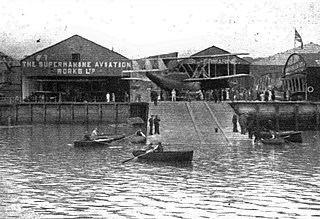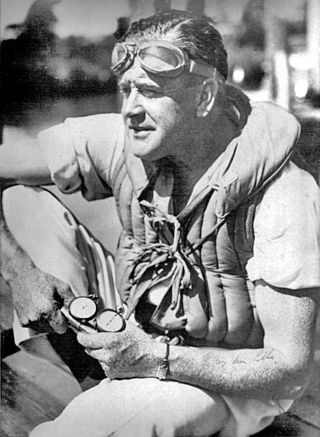Related Research Articles

Imperial Airways was an early British commercial long-range airline, operating from 1924 to 1939 and principally serving the British Empire routes to South Africa, India, Australia and the Far East, including Malaya and Hong Kong. Passengers were typically businessmen or colonial administrators, and most flights carried about 20 passengers or fewer. Accidents were frequent: in the first six years, 32 people died in seven incidents. Imperial Airways never achieved the levels of technological innovation of its competitors and was merged into the British Overseas Airways Corporation (BOAC) in 1939. BOAC in turn merged with the British European Airways (BEA) in 1974 to form British Airways.

Supermarine was a British aircraft manufacturer. It is most famous for producing the Spitfire fighter plane during World War II. It also built a range of seaplanes and flying boats, winning the Schneider Trophy for seaplanes with three wins in a row in 1927, 1929 and 1931. After the war, the company produced a series of jet fighters.

British Airways Ltd was a British airline company operating in Europe in the period 1935–1939. It was formed in 1935 by the merger of Spartan Air Lines Ltd, United Airways Ltd, and Hillman's Airways. Its corporate emblem was a winged lion.

The Avro 618 Ten or X was a passenger transport aircraft of the 1930s. It was a licensed version by Avro of the Fokker F.VIIB/3m.

Hubert Scott-Paine was a British aircraft and boat designer, record-breaking power boat racer, entrepreneur, inventor, and sponsor of the winning entry in the 1922 Schneider Trophy.

The Supermarine Southampton was a flying boat of the interwar period designed and produced by the British aircraft manufacturer Supermarine. It was one of the most successful flying boats of the era.

The Felixstowe F.5 was a British First World War flying boat designed by Lieutenant Commander John Cyril Porte RN of the Seaplane Experimental Station, Felixstowe.

Royal Air Force Calshot or more simply RAF Calshot was initially a seaplane and flying boat station, and latterly a Royal Air Force marine craft maintenance and training unit. It was located at the end of Calshot Spit in Southampton Water, Hampshire, England, at grid reference SU487024. It was the main seaplane/flying boat development and training unit in the UK, with the landing area sheltered by the mainland, to the west, north and east, and the Isle of Wight, a few miles away to the south on the other side of the Solent, where seaplanes and flying boats were mass-produced by Saunders-Roe. It closed in 1961. Much of the former base has been preserved, with most of the site now being occupied by the Calshot Activities Centre.
Instone Air Line was an early British airline from 1919 to 1924. Along with other private airlines of the time, it was absorbed into Imperial Airways.

The Supermarine Swan was a 1920s British commercial biplane flying boat designed by R.J. Mitchell. A single machine was built by Supermarine at their works at Woolston, Southampton. The world's first twin-engine amphibian aircraft, it was the precursor to the Supermarine Southampton.
Daimler Airway was an airline subsidiary of the Birmingham Small Arms Company (BSA)'s Daimler Company. It was created to use some of the assets of the failed ventures Airco and its subsidiary, Aircraft Transport and Travel, which was acquired by BSA in February 1920.

The Supermarine Sea Eagle was a British, passenger–carrying, amphibious flying boat. It was designed and built by the Supermarine Aviation Works for its subsidiary, the British Marine Air Navigation Co Ltd, to be used on their cross-channel route between Southampton, the Channel Islands and France.

The Saro Cloud was a British passenger amphibian flying boat designed and built by Saunders-Roe as the A.19. It was later produced as the A.29 for the Royal Air Force for pilot and navigator training.

Jersey Airways was an airline that operated air services to and from the Channel Islands from 1933 until 1947, when it became part of British European Airways.

The Supermarine Channel was a modified version of the AD Flying Boat, purchased by Supermarine from the British Air Ministry and modified for the civil market with the intention of beginning regular air flights across the English Channel. The aircraft were given airworthiness certificates in July 1919. The Mark I version, later called the Channel I, was powered with a 160 horsepower (120 kW) Beardmore engine; a variant designated as Channel II was fitted with a 240 horsepower (180 kW) Armstrong Siddeley Puma engine. Designed by Supermarine to accommodate up to four passengers, the company produced a series of interchangeable interiors that could be used at short notice, which enabled the Channel to be used as a fighter or for training purposes.
British Aviation Services Limited (Britavia) was an early post-World War II airline holding company and air transport operator that could trace its roots back to 1946. Its main activities included trooping, inclusive tour (IT) and worldwide passenger and freight charter services. British Aviation Services' first investment in a British independent airline occurred in 1946, when it acquired a minority interest in Silver City Airways. Silver City Airways operated the world's first cross-Channel air ferry service on 13 July 1948. It subsequently became British Aviation Services' biggest operating division. In 1953, British Aviation Services took over the independent airline Air Kruise. The same year, BAS Group also took control of Aquila Airways, the last commercial flying boat operator in the United Kingdom. The completion of these acquisitions by mid-1954 resulted in a reorganisation of the British Aviation Services group, with British Aviation Services Ltd (BAS Group) becoming the group's holding company and Britavia one of its operating subsidiaries. By the late 1950s, BAS Group became Britain's largest independent airline operator. Its numerous operating divisions included Britavia's Hermes Division at Blackbushe Airport and Aquila Airways's Flying Boat Division at Hamble near Southampton. The former concentrated on trooping services and inclusive tours while the latter provided scheduled services to Portugal, the Canary Islands and Italy. In 1962, BAS Group merged with British United Airways (BUA), which by that time had replaced BAS as the UK's largest independent airline operator.
Hillman's Airways was a 1930s British airline which later became part of British Airways.
National Air Communications was a British government organisation that directed civilian flying operations from the outbreak of World War II until April 1940.
Franklyn Leslie Barnard was a British pilot, who took part in 1920s air races and airline flights. He was also known as Captain F. L. Barnard.
British Air Transport – The Pioneering Days 1919–1934 is an 8.44-metre (27.7 ft)-long mural by William Kempster depicting, from left to right, a chronological sequence of events in the history of British aviation on the London to Paris route starting on the left with Hounslow Heath Aerodrome in 1919 and finishing on the right at Croydon Aerodrome in 1931. The most recent aircraft shown is the Short L.17 Scylla of 1934.